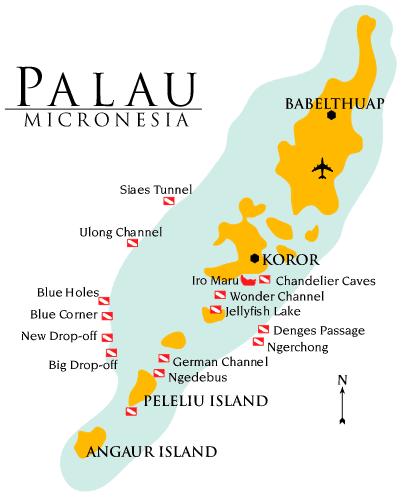Palau
Introduction
Palau (or Belau, as referred to by natives) is an island nation in the Pacific Ocean, about 800 km east of the Philippines. It gained its independence in 1994, making it one of the youngest nations; for this reason, the name of Palau itself is relatively unknown among travelers... expect for divers!
With over 200 islands, Palau offers some of the best diving sites in the world. The underwater scenery is incredible, with almost everything from vertical walls, channels, underwater tunnels and caves to lagoons. The variety of fish is amazing, and there are plenty of pelagic species (sharks, mantas). Wreck amateurs will be delighted by the numerous wrecks of Japanese warships and planes from WWII. The visibility underwater is usually excellent, although during the rainy month (from July to October) is can be lower, when the access to the best diving sites can sometimes not be possible for up to a week. Water temperature is stable at around 27-29 degrees Celsius year round
Palau is best enjoyed on a liveaboard cruise. This allows tackling the marvels of the nature, including the world famous Jellyfish Lake on Eil Malk island.
Travel facts
Calendar
| Jan | Feb | Mar | Apr | May | June | July | Aug | Sep | Oct | Nov | Dec |
| 29 | 29 | 28 | 28 | 28 | 27 | 26 | 26 | 27 | 27 | 28 | 29 |
| 28 | 28 | 28 | 28 | 28 | 27 | 27 | 27 | 27 | 28 | 28 | 28 |
Infrastructures
-
Eclipse (liveaboard)telephone : (680) 488-1505fax : (680) 488-5003address : Box 1716, Koror, Palau 96940email : saildive@palaunet.cominternet : www.palau-divensail.comrating : 4 / 4 starscomments :One of the inconvenience of cruise boats is that it is pretty difficult to get reliable information on the staff on board. Indeed, the turn-over on those boats is usually at most a couple of years, and comments found on the internet (including on this site) are somehow obsolete as the staff that will serve you is different from the one you read about. But this is not going to happen on board of the Eclipse, as it is always the two same persons you will find on board: the skipper John McCready, a 60-years old American guy who spent the last 15 years cruising around Palau, and his young Chinese-born wife Charlie, who acts both as divemaster and cook.
Let us be straight, the Eclipse can not be considered as a luxurious boat - and John himself writes that on his web site; this 12-meters long sail boat can host up to 4 passengers; there is a double bed in the small forward cabin with an attached toilet, as well as an aft cabin with one small double bed and a single one - this cabin is larger, but has virtually no intimacy as the door opening toward the boat stays open at all time and the toilets are shared with the staff. There is no inside shower, but people can wash themselves on the deck with heated water. If the comfort is not the one you can see on most of the cruise boats, this cruise has many advantages
First of all, John and Charlie really take care of their guests - much more than what could be expected on any dive cruise (even the luxurious ones). A true friendship quickly links them to their 2 to 4 guests, which ensure that the holidays will be great ones. It is thus possible to discuss the cruise program, the diving types and sites, and even the organization of the daily life on board - which would be unthinkable on a larger vessel. Food is simply great - and this is really important on a dive boat - with dishes that are as exotic as tasty. Dives are available whenever requested, with a divemaster who not only makes anything to please the divers, but also really knows the area extremely well! And Charlie is also a gifted underwater photographer, who will give you a copy of the pictures she took during your dives. Whether you want to do intensive diving, snorkeling, kayak, sailing, walk on beautiful islands, discover local culture, make pictures or simply rest, this cruise is really for you, if you can handle a lower level of comfort. -
Ocean Hunter I (liveaboard)telephone : 680 488 2637fax : 680 488 5418address : PO Box 964, Koror, Palau 96940email : info@oceanhunter.cominternet : www.oceanhunter.comrating : 3 / 4 starscomments :The Ocean Hunter I is a cruising boat that can accommodate a maximum of six divers, divided into three cabins (one very spacious, one smaller and one decidedly small with two bunk beds). The boat has a comfortable area for meals, a wide sundeck and space in the bow to store wetsuits and other personal equipment. The crew consists of three members: the captain/divemaster (Siksei), the pilot/divemaster (Troy) and the cook (Arlee). All three went out of their way to satisfy our wishes. The food was very well prepared: hearty breakfasts, cakes and milkshakes for the breaks, and even sashimi and sushi on one occasion. Unfortunately, it's not the cook who chooses the basic ingredients, and we ended up with chicken and minced beef too often to our liking... It took all Arlee's imagination to turn this into an interesting meal. Unfortunately for us, the weather wasn't very kind, so fishing was difficult, and only once did we get fresh fish - a shame when you're on a cruise ship (by the way, all drinks are extra - US$30 for a bottle of wine and US$3.5 for a beer). For a cruise of this price, the overall food quality was simply not acceptable.
The service offered on the Ocean Hunter is really top-notch, and perfectly suited to divers who want to avoid the crowds. Thanks to its design, the boat can be used to dive directly on most sites, the annex being used only for shallow sites or in case of bad weather. Life on board is very pleasant - thanks once again to the crew. Two other negative points can be attributed to the organizers: unlike what is being advertised, there are only 6 days of diving, not 7, as the first morning is lost, and the boat is back to the harbour at 4 p.m. the day before the end of the cruise; and each diver has to buy a metal hook at US$15 to hang onto the reef during drift dives (considering that it is not possible to use this kind of tool elsewhere, they could still be made available on the boat, just like weights). Even so, we can't help feeling that the overall price is too high, especially since it was increasing several year by US$100-200 per person per stay!
Diving Sites
-
description :Blue Cornerrating : 5.0level : for advanced diversdepth : 30 mvisibility : 25 m
The mythical diving site of Palau. After exiting the cave from Blue Holes, turning on the left, divers reach a vertical wall falling down to more than 60 meters. The depth is pretty attractive, and divers will need to carefully monitor their computer! This is a drift dive, with a current that can be so strong that the only way to stop - for example to look a little longer at the fauna - is to use a hook to attach yourself to the reef (using dead coral only, obviously !). Divers usually spend at least 10 minutes, sometimes much longer, hooked above the wall; current can be violent, but the more current, the more pelagic animals to see.
Drifting along the wall, the spectacle is simply unbelievable: schools of sharks with more than 30 of them are found just next to the divers, coming sometimes really close. We were followed by a school of sharks for half an hour. Schools of bumphead parrots and barracudas, as well as a turtle and a napoleon were also seen. Most divers will focus on big animals on this site, but it is worth to underline than there are lots of coral fish, too.
This is simply one of the best diving sites we have seen all around the world.
Several dives - all different from each others - are possible on this site. One day, we had the opportunity to dive three times on Blue Corner. After a long drift, a more quiet area is reached. We found there a huge school of barracudas, but only a single shark. Three turtles - together. The last dive on this site, apart of the (almost usual) schools of barracudas and some sharks, we saw a huge school of black snappers. On a recent trip to Palau, during a single dive on this site, we saw half-dozen of sharks (grey and whitetip), two huge (again !) schools of barracudas and black snappers, two large napoleons swimming very close to us, and 5 bumphead parrots... as well as all the usual reef fish. -
description :Barnum's Wallrating : 4.0
Located not far from the German Channel, outside the lagoon, this dive site is relatively protected and can usually be dived even if the wind is strong. The diving here might be not as spectacular as Blue Corner or New Drop-Off, but the corals are very attractive. The underwater scenery is interesting, divers can find themselves along a vertical wall, then is small canyons or over a slope. There are lots of hard corals, and some soft one, too. Overall, they are in excellent conditions, and divers who take their diving slowly will be able to enjoy it very much. It is probably a good place for macro photography, too. Two white tip sharks, two moray eels, a lobster, interesting anemones that closed themselves, taking the shape of a cube, some nudibranchs, two pufferfish. At 3 meters, on the top of reef, lots of fish can be observed, too. -
description :Blue Holesrating : 4.0level : only for advanced divers!depth : 26 mvisibility : 25 m
Many destinations in the world have a diving site called Blue Hole. Among them, this one in Palau is clearly one of the most impressive. Four openings yield access to a huge cave, from where divers can exit on the vertical wall nearby. The dive starts on the top of the reef, where a large hole with a diameter of 5 to 10 meters leads divers to the bottom of the cave, 26 meters below the surface. From there, the sight of the openings spreading sun light down to the cave is stunning. Otherwise, there is not a lot to seen there (except nice corals on your way down), and fauna is very limited (sometimes only some sharks can be seen). It is possible to continue the dive along the wall, toward Blue Corner (although the latter is relatively far); the first part of the journey to Blue Corner is less interesting.. -
description :New Drop-Offrating : 4.0level : for beginnersdepth : 20 m
Drift dive along a wall forming a 90 degrees angle. Several sharks have been seen, but only isolated individuals, no school. Two large humphead wrasse followed us most of the dive; we also encountered a school barracudas and a blue-lined snappers. The reef above the wall is at a depth of 8 meters, and thus shallower than Blue Corner. Like at Blue Corner, it is necessary to use a hook, fixed on a piece of dead coral, to be able to enjoy the scenery - pelagic and reef fish. This is a very nice dive, although less impressive than Blue Corner, located nearby. -
description :Ngemelis Wallrating : 4.0level : for beginnersdepth : 15 mvisibility : 15 m
Vertical well. Unlike most dives of this type, this one offers a magnificent spectacle sight of soft corals. Red, violet and green and the dominant colors here, creating a painting where most reef fish are seen. Hard corals - especially gorgonians - are also impressive. Several anemones with their clown-fish, as well as nudibranchs. A school of black snappers, a turtle, a humphead wrasse (napoleon) and some sharks. Three leaf-fish... always difficult to identify. We also saw, on the top of the reed, a crown-of-thorns starfish (acanthaster, the starfish eating corals).
Interesting during the day time, this site is especially amazing at night. Probably one of the best night dive we have ever made. Directing a flashlight toward the wall will render an incredible number of red tones: the wall seems covered by red corals. Even if there are relatively few fish, the colors seen here are an incredible magnet for divers, and so are nudibranchs (including an Asteronotus with a diameter of 30 cm), crabs and small shrimps. -
description :Siaes Tunnelrating : 4.0level : only for advanced divers!depth : 35 mvisibility : 15 m
This huge tunnel is pretty deep, and thus reserved for advanced divers. The entrance is at a depth of 30-32 meters, but its bottom is located at about 45 meters. Unusually large with a diameter of more than 10 meters, and a length of about 50 meters. While it is bright enough, and a flashlight is not mandatory, it is still recommended to observe that back corals and the gorgonians on the ground. After exiting the tunnel and climbing to 25 meters, divers will follow a wall where turtles and sharks are often encountered. -
description :Turtle Wallrating : 4.0level : for beginnersdepth : 12 mvisibility : 15 m
A wall covered by corals. Large variety of soft and hard ones. Using a flashlight will reveal intense red colorations. Sharks, turtles, morays, groupers, a napoleon and a scorpion-fish add extra value to the scenery. Since most of the dive takes place at a shallow depth, this location is also attractive for snorkeling. -
description :Ulong Channel (Ngerumekaol Pass)rating : 4.0level : for beginnersdepth : 25 mvisibility : 12 m
Known as one of the best drift dive in Palau. East of Ulong Island, a large coral reef reaching just under the surface can be found. The only access is a channel where this dive takes place.
Depending on the tide, the current can either flow toward the island or away of it (the visibility will be function of that current); it is often strong, and divers are carried toward the channel without having to swim. The channel has a depth of 9-12 meters, and hosts a good variety of animals. But the real interest of this dive is the outside wall of the feer, where sharks are often encountered. We saw about 10 of them during our dive, as well as a turtle, and the previous day in the channel, a stingray.
This channel is a very pleasant spot for a dive in the late afternoon. -
description :Chandelier Caverating : 3.0type of diving : cavelevel : only for advanced divers!depth : 8 mvisibility : changing
Located close to the diving centers, this cave is easily accessible. The entrance is located at 9 meters under the surface. From there, sunlight can be seen and is a good indicator of the exit; it is therefore important - as for all cave dives - not to stir the sand at the bottom of the cave, or the visibility will drop from very good to zero. After about 10 meters, divers can surface inside a first air pocket, where stalactites can be seen. All together, there are four chambers that can be visited, the last one being the most interesting; in that one, you can remove your gear and walk carefully toward the inside of the cave, exploring galleries under the island.
The reef around the cave entrance is no interest. However, you can find several mandarin fish - if you know where to look. If you can dive here in the morning, you probably will encounter a better visibility, as it can get crowded in the afternoon. -
description :German Channel Gardenrating : 3.0level : for beginnersdepth : 15 m
Due to the presence of a wall rather than a gentle slope, this dive site is not very suitable for a night dive. We still dived there at night, especially because the fauna is quite attractive in the obscurity: lion-fish, a scorpion-fish, some lobster, a moray, pufferfish as well as a parrot sleeping. Some tiny worms can be found sticking to the divers' flashlights. -
description :Iro Marurating : 3.0type of diving : wrecklevel : for advanced diversdepth : 35 mvisibility : 5-10 m
Wreck of a Japanese fleet replenisher and oiler. It was sunk in 1944, together with most of the Japanese war boats that were anchored in Palau, during the US operation called Desecrate 1. Iro was launched in 1922, and has a length of 143 meters. Due to its length, swimming along the whole wreck takes most of the diving time, leaving limited opportunities for penetration. The bottom of the wreck is at a depth of 35 meters, and most of the structure is below 20 meters, which means that divers get saturated here relatively fast. The structure of the Iro is in good condition, and penetration is possible in many places - at the same time, deep penetration is not recommended and can be pretty dangerous. Some oil tanks can still be seen. Visibility in the wreck can quickly drop to zero because of the presence of sand on the bottom. Among the interesting feature of the boat is the gun battery, which can be easily recognized on the back of the ship. The stern of the Iro is also interesting, but is relatively deep. Most divers finish their dive following the mast on the aft of the ship; rising vertically to a depth of about 10 meters. This mast is covered with corals, including a large number of anemones with clown-fish. Visibility around the wreck is ranging between low to average. -
description :Soft Coral Archrating : 3.0level : for advanced diversdepth : 9 mvisibility : changing
Site near Ngeruktabel island. At a depth of 7-9 meters, a long tunnel bring divers to a cave with an air pocket. The visibility is especially clear, and usually significantly better that the one found outside. In the tunnel, two lobsters were seen. Since the tunnel is rather narrow, it is important to control one's floatability, as stirring sand would lower the visibility. Another interesting place, outside the cave, is a passage - from the surface to about 3 meters - linking to the other side of the island. The presence of backwash usually requires to wait about 20 seconds before a favorable current will bring the diver to the other side.
Apart those two spots - visited altogether in less than 20 minutes - this dive site is of no interest. -
description :Turtle Coverating : 3.0level : for advanced diversdepth : 20 mvisibility : 15 m
The diving starts through a vertical opening in the coral. Divers then exit by a big hole in the wall, at a depth of about 20 meters (another opening is also available at a shallow depth), and then follow the wall with the current. A school of golden snappers was waiting at the mooring, just next to the blue hole. On the wall itself, there is limited life only. But after 40 minutes of swimming, the wall makes an angle: the plateau about us, at a depth of 7-8 meters, is a fantastic vantage point with many schools of fish : triggerfish, pyramid butterfly fish, fusiliers (always impressive as a school, as the color of the group seems to be changing when they turn around), sweetlips, titan triggerfish. 1-2 sharks have also been spotted. Clearly, this plateau is the most interesting area of that dive site. -
description :Big Drop-Offrating : 3.0
A vertical wall covered with hard and soft corals. This dive site has usually less current than other walls around (Blue Corner, New Drop Off), and the top of the wall is very shallow, at about 3 meters. All colors can be seen on this wall - the red color is especially dominant; diving with a torch is a must. There are lots of small interesting things to see on the wall - corals of course, but also nudibranchs, juveniles, lobster, lion-fish. Macro photographers will appreciate the variety of nudibranchs (some being unusually large). There are less large animals: one large shark only, one turtle, one grouper, one spotted eagle ray in the blue. This dive site is especially recommendable for the second or third dive of the day, as most features are seen between 5 and 15 meters, and current is, as we said, limited. -
description :German Channelrating : 2.5level : for beginnersdepth : 18 mvisibility : 10-15 m
To bring the fertilizer found on Angaur, the southern island of Palau, to the capital Koror, German decided to build a channel trough the reef so that their barges would be able to travel to Koror inside the lagoon, thus protected from strong winds. The channel is about 800 meters long, and at high tide, it is about 4 meters depth. Diving takes place around the entrance of the channel, inside the lagoon. Many pinnacles of coral on a sandy bottom. Some current can be encountered, depending on the tide. Although this site is known to host mantas, we did not see any during our first dive. We however could spot a large grey shark, two turtles, some lion-fish and a huge grouper. Also of interest, an eel garden et many giant clams (the largest being about 1 meter long !). Lots of fish, and during the whole dive, we were followed by a school of fish. During a second dive on the same site, we waited for 30 minutes on the bottom at 18 meters at a spot called Manta Cleaning Station. A manta finally came very close to us.
This site, also used for night dives, is clearly less interesting than those located on the other side of the channel, just outside the lagoon. -
description :Buoy 6rating : 2.0type of diving : wrecklevel : for advanced diversdepth : 25 mvisibility : 8 m
This dive takes place in and around the channel used by boats to leave Koror. A strong current is often present on this site, whose major interest is a wreck of a 35 meter-long unidentified Japanese fishing boat, sunk at a depth of 18-25 meters. The wreck, which is less visited than those around, is especially interesting with lots of coral and, among other things, nudibranchs and lion-fish. Less things to see on the nearby reef. -
description :Helmet Wreckrating : 2.0type of diving : wreckdepth : 30 mvisibility : 5 m
Located just a couple of minutes from most diving centers, this wreck is also called Depth Charge Wreck, because of its freight still visible on the deck - helmets smelted together by the time and the underwater mines. A riffle and some empty bottles of alcohol are also found in several areas of the boat. The depth of this dive is between 12 and 30 meters, and the inside of the ship can be easily visited. Because of the low visibility and the absence of an interesting fauna, this dive is not that appealing. -
description :Jake Seaplanerating : 2.0type of diving : wrecklevel : for beginnersdepth : 10 mvisibility : 8 m
Wreck of a Japanese sea plane (American acronym: Jake) lying on a sandy bottom at a shallow depth (10 meters). The wreck of this plane is in a good condition, with the cockpit, the propeller and the wings easily recognizable. The reef around the wreck offers only limited interested. -
description :Ngerchong Insiderating : 2.0level : for beginnersdepth : 15 mvisibility : 8 m
Inside the coral reef, a site with limited interest. A squid, an octopus, some nudibranchs but mostly dead corals. -
description :Ngerchong Outsiderating : 2.0level : for beginnersdepth : 40 mvisibility : 10 m
Moderate slope covered with mostly dead corals. At 42 meters, we encountered a leopard-shark lying on the sand, with a pilot-fish attached to it. Also two sea snakes, one of them being really impressive with a length of two meters. Some white tip sharks and a napoleon. Lots of large giant clams. There are surprising underwater current on this web site, some being especially cold. -
description :Ngedebus Coral Gardenrating : 2.0depth : 15 m
Located outside the lagoon, this dive site is relatively sheltered, and therefore is a good location for night dives. From the mooring, divers swim toward the rocks, at a depth between 15 meters and the surface. Limited interest on this location, although sharks can be usually seen at night. -
description :Cemetaryrating : 1.0level : for beginnersdepth : 10 mvisibility : 2-8 m
A snorkeling site before being a diving site... At shallow depth - 0 to 10 meters - lots of corals and fish (a school of 15 barracudas, 2 napoleons, 2 bumphead parrots, 5 squids, among other animals). However, the site is quite small, and visibility can be really bad; only an option when all the good dive sites are unreachable. -
description :Chuyu Marurating : 1.0type of diving : wrecklevel : for advanced diversdepth : 35 mvisibility : 5 m
Discovered in 1990 by Toribiong and Lindemann, this wreck near Malakal Island is only of limited interest - in our opinion. This dive is quite deep (the bottom is at 36 meters), and visibility is usually bad because of the turbidity of the water. We saw a crocodile-fish. -
description :Jellyfish Laketype of diving : snorkeling onlylevel : for beginnersdepth : 0 m
While still nowadays this place is classified as a diving site in Palau guide books, it is in fact not allowed to dive there, and snorkeling is the only allowed activity in the lake. At a precise depth, a large concentration of very toxic sulfhydric acid is encountered, which anyway always made diving here a potentially dangerous activity. Apart of all divers who get off their cruise boat to swim in Jellyfish Lake, a large number of tourists come from Koror for a day-trip. The lake is reached after 10 minutes of hiking on stony steps - boots are strongly recommended!
The number of jellyfish can dramatically change, but is around a couple of hundred thousands; during the El Niño period in 1997-98, their number dropped to a small number, before raising again later. Jellyfish usually gather in the middle of the lake, in a water that is usually greenish - and only very unusually blue as you can see in the magazines. Since they have no predator, jellyfish lost their poisonous properties... No risk to get any rash on your skin! This site is really a must-do, although it is not a dive.
There is now a hefty permit to access the lake. -
description :Mandarin Fishlevel : for beginnersdepth : 2 mvisibility : 5 m
Almost completely surrounded by land, the only attraction of this very shallow dive is the presence of several mandarin fish. A mask and a snorkel is all you need to explore this place. In fact, the most amazing part of this dive was to see a group of five divers, equipped with nitrox tanks, taking pictures for about 10 minutes of a single mandarin fish - which indeed is quite cute - at a depth of... 2 meters... -
description :Bat Cavelevel : for beginnersdepth : 3 mvisibility : 5 m
This diving site is a good option when sea is really rough et boats can not go out of the harbor. But you have to realize that if you can dive somewhere else, it would probably be a better choice! The site is located in front of a cave that can be visited by a (small) boat, and inhabited by bats. At a shallow depth, some corals and reef fish are seen.







































-mini.jpg)















































